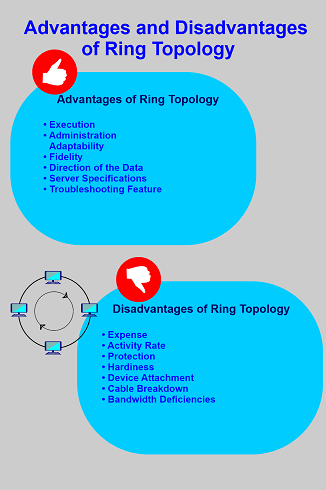Ring Topology Advantages and DisadvantagesTo understand the advantages and disadvantages, first we have to know about the what is Ring Topology? So, let's begin with introduction. What is Ring Topology?To create a circular network model, each host machine connects to the other two devices in a ring topology. When one host tries to send a message or to communicate with a non-adjacent host, the data moves through all the intermediate hosts to reach the desired host. Only one extra cable may be needed to connect and wait for one more host by the administrator in the existing node structure. The whole ring topology losses when any of the hosts fail to connect. Thus every connection in the ring topology is a point of failure. Due to that reason, one more backup ring must be required. In this context, we will learn the advantages and disadvantages of ring topology along with its features of it. Some important features of ring topology:
Advantages of Ring Topology:1. Execution: We can achieve a ring topology by executing the network with less effort. The devices can be arranged one after the other without a specific number. There are no limitations to the number of devices that we can place. Whenever we add new devices, we need to move the adjoining device. 2. Administration: Another classic feature of a ring network topology is high-speed data transfer. Here is a ring topology; the transmission of data that occurs between each workstation is quite fast. The interruption in the condition of the heavy load will not impact the performance. 3. Adaptability: The construction of ring topology makes the adaptability of devices straightforward. The users will add a workstation, and it will not create any performance delay or problems in the network. 4. Fidelity: The ring topology requires hardiness. Besides, it can still be quite reliable for use, mainly by using a set of multiple rings. The bidirectional characteristics of the ring topology guarantee very few failures. The data moves in two directions in a ring topology; for that reason, for the same node, various paths are used. 5. The direction of the data: The ring topology One Direction data flow ensures a few chances of data collisions. Therefore, the data transfer process in a ring topology is more fluid. 6. Server specifications: The need of network servers in a ring topology is not needed because all the workstations are connected circularly in it. Therefore, in a ring topology, unique connectivity is maintained in each workstation. The use of special cables is the only element that is necessary for the ring topology to connect each device understructure. 7. Troubleshooting feature: The error and troubleshooting in a ring topology are relatively straightforward rather than one-directional. In case of any type of failure, ring topology, all of the workstations present in it after the malfunctioning computer will quit working. Hence the user can spend less time classifying the place of network failure. 
Disadvantages of Ring Topology:1. Expense: For establishing the network originally, a ring topology architecture requires expensive hardware components. We cannot link the workstation without the proper network cards And cables which makes the installation process pretty high. Hence it is desirable for users with a fixed budget to try some other options. 2. Activity rate: A high-speed data transfer rate is maintained in ring topologies, but it is more leisurely than a star topology. The data passes through every workstation at the time of transferring from one device to another, which causes a lag in the time while the data reaches its destination. Therefore the whole network activity rate is slowed. 3. Protection: The data in the ring topology system passes through each workstation attached. Every workstation connected can access the information up another station wait, we create a few privacy issues; why consider the unauthorized individuals who can easily interrupt users' sensitive information. 4. Hardiness: Most ring topology network users take the one-directional path, which means that each device is interdependent. Suppose any of the workstations breaks down, then all of the networks will be destroyed. 5. Device Attachment: When a new node is attached or disconnected from the existing ring topology, it causes disturbances in the network activity. Every workstation on a ring topology is interlinked, which means that users need to bear the trouble of breaks or breakdowns during network changes. 6. Cable Breakdown: The entire network in a ring topology depends heavily on a single cable. Several network nodes are placed circularly on this cable. By accident, if the connector experiences any failure, the signals will face a blockage and stop traveling. 7. Bandwidth Deficiencies: Ring topology is minimal when it comes to bandwidth. If there are multiple devices connected, that could create bandwidth deficiencies. As a result, the users may experience communication impediments, which is why it is advisable to ensure that a few nodes are connected in a ring topology. A Comparison Table for Advantages and Disadvantages of Ring Topology
Summary:In this context, we have learned all about Ring Topology with its advantages and disadvantages. |
 For Videos Join Our Youtube Channel: Join Now
For Videos Join Our Youtube Channel: Join Now
Feedback
- Send your Feedback to [email protected]
Help Others, Please Share










